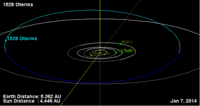| Discovery[1] | |
|---|---|
| Discovered by | Y. Väisälä |
| Discovery site | Turku Obs. |
| Discovery date | 26 January 1938 |
| Designations | |
| (1529) Oterma | |
Named after | Liisi Oterma (astronomer)[2] |
| 1938 BC · 1950 PV 1959 RD1 · A912 VO | |
| main-belt · Hilda[3] | |
| Orbital characteristics[1] | |
| Epoch 4 September 2017 (JD 2458000.5) | |
| Uncertainty parameter 0 | |
| Observation arc | 66.76 yr (24,385 days) |
| Aphelion | 4.7933 AU |
| Perihelion | 3.1916 AU |
| 3.9924 AU | |
| Eccentricity | 0.2006 |
| 7.98 yr (2,914 days) | |
| 50.497° | |
| 0° 7m 24.96s / day | |
| Inclination | 9.0582° |
| 100.59° | |
| 295.08° | |
| Jupiter MOID | 0.8116 AU |
| Physical characteristics | |
| Dimensions | 54.40 km (calculated)[3] 56.327±0.285[4] 60.16±1.11 km[5] |
| 15.75 h[6] | |
| 0.047±0.002[5] 0.054±0.003[4] 0.057 (assumed)[3] | |
| Tholen = P[1] · P[3] B–V = 0.764[1] U–B = 0.386[1] | |
| 10.05[1][3][5] · 10.11±0.26[7] | |
1529 Oterma, provisional designation 1938 BC, is a reddish, rare-type Hildian asteroid from the outermost region of the asteroid belt, approximately 56 kilometers in diameter. It was discovered on 26 January 1938, by Finnish astronomer Yrjö Väisälä at Turku Observatory in Southwest Finland.[8] It is named for Liisi Oterma.[2]
Orbit and classification

Oterma is a member of the Hilda family, a large group of asteroids that orbit in resonance with the gas giant Jupiter. Hildian asteroids are thought to have originated from the Kuiper belt in the outer Solar System.
It orbits the Sun in the outer main-belt at a distance of 3.2–4.8 AU once every 7 years and 12 months (2,914 days). Its orbit has an eccentricity of 0.20 and an inclination of 9° with respect to the ecliptic.[1]
It was first identified as A912 VO at Winchester Observatory in 1912 (799). The body's observation arc begins at Turku a few weeks after its official discovery observation.[8]
Physical characteristics
Oterma belongs to an exclusive group of 33 known asteroids with a spectral P-type in the Tholen classification scheme.[9]
Photometry
During a study of 47 Hilda asteroids in the 1990s, a rotational lightcurve of Oterma was obtained from photometric observations at the Swedish Uppsala Astronomical Observatory and other places. It gave a rotation period of 15.75 hours with a change in brightness of 0.18 magnitude (U=2).[6]
Diameter and albedo
According to the space-based surveys carried out by NASA's Wide-field Infrared Survey Explorer with its subsequent NEOWISE mission and by the Japanese Akari satellite, Oterma measures 56.33 and 60.1 kilometers in diameter and its surface has an albedo of 0.054 and 0.047, respectively.[4][5] The Collaborative Asteroid Lightcurve Link assumes a standard albedo for carbonaceous asteroids of 0.057 and calculates a diameter of 54.40 kilometers, with an absolute magnitude of 10.05.[3]
Naming
Oterma was named for Liisi Oterma (1915–2001), first Finnish female astronomer with a PhD and a discoverer of minor planets and comets at the Turku observatory between 1939 and 1953.[2] The official naming citation was published by the Minor Planet Center on 20 February 1976 (M.P.C. 3929).[10]
References
- 1 2 3 4 5 6 7 "JPL Small-Body Database Browser: 1529 Oterma (1938 BC)" (2017-03-29 last obs.). Jet Propulsion Laboratory. Retrieved 30 June 2017.
- 1 2 3 Schmadel, Lutz D. (2007). "(1529) Oterma". Dictionary of Minor Planet Names. Springer Berlin Heidelberg. p. 121. doi:10.1007/978-3-540-29925-7_1530. ISBN 978-3-540-00238-3.
- 1 2 3 4 5 6 "LCDB Data for (1529) Oterma". Asteroid Lightcurve Database (LCDB). Retrieved 31 December 2016.
- 1 2 3 Grav, T.; Mainzer, A. K.; Bauer, J.; Masiero, J.; Spahr, T.; McMillan, R. S.; et al. (January 2012). "WISE/NEOWISE Observations of the Hilda Population: Preliminary Results". The Astrophysical Journal. 744 (2): 15. arXiv:1110.0283. Bibcode:2012ApJ...744..197G. doi:10.1088/0004-637X/744/2/197. S2CID 44000310. Retrieved 31 December 2016.
- 1 2 3 4 Usui, Fumihiko; Kuroda, Daisuke; Müller, Thomas G.; Hasegawa, Sunao; Ishiguro, Masateru; Ootsubo, Takafumi; et al. (October 2011). "Asteroid Catalog Using Akari: AKARI/IRC Mid-Infrared Asteroid Survey". Publications of the Astronomical Society of Japan. 63 (5): 1117–1138. Bibcode:2011PASJ...63.1117U. doi:10.1093/pasj/63.5.1117. (online, AcuA catalog p. 153)
- 1 2 Dahlgren, M.; Lahulla, J. F.; Lagerkvist, C.-I.; Lagerros, J.; Mottola, S.; Erikson, A.; et al. (June 1998). "A Study of Hilda Asteroids. V. Lightcurves of 47 Hilda Asteroids". Icarus. 133 (2): 247–285. Bibcode:1998Icar..133..247D. doi:10.1006/icar.1998.5919. Retrieved 16 August 2016.
- ↑ Veres, Peter; Jedicke, Robert; Fitzsimmons, Alan; Denneau, Larry; Granvik, Mikael; Bolin, Bryce; et al. (November 2015). "Absolute magnitudes and slope parameters for 250,000 asteroids observed by Pan-STARRS PS1 - Preliminary results". Icarus. 261: 34–47. arXiv:1506.00762. Bibcode:2015Icar..261...34V. doi:10.1016/j.icarus.2015.08.007. S2CID 53493339. Retrieved 31 December 2016.
- 1 2 "1529 Oterma (1938 BC)". Minor Planet Center. Retrieved 31 December 2016.
- ↑ "JPL Small-Body Database – Query spectral type P (Tholen)". JPL Solar System Dynamics. Retrieved 16 August 2016.
- ↑ Schmadel, Lutz D. (2009). "Appendix – Publication Dates of the MPCs". Dictionary of Minor Planet Names – Addendum to Fifth Edition (2006–2008). Springer Berlin Heidelberg. p. 221. Bibcode:2009dmpn.book.....S. doi:10.1007/978-3-642-01965-4. ISBN 978-3-642-01964-7.
External links
- Asteroid Lightcurve Database (LCDB), query form (info Archived 16 December 2017 at the Wayback Machine)
- Dictionary of Minor Planet Names, Google books
- Asteroids and comets rotation curves, CdR – Observatoire de Genève, Raoul Behrend
- Discovery Circumstances: Numbered Minor Planets (1)-(5000) – Minor Planet Center
- 1529 Oterma at AstDyS-2, Asteroids—Dynamic Site
- 1529 Oterma at the JPL Small-Body Database